牛津必修3 Unit 3 Back to the past语法 主谓一致 42PPT
文档属性
| 名称 | 牛津必修3 Unit 3 Back to the past语法 主谓一致 42PPT | 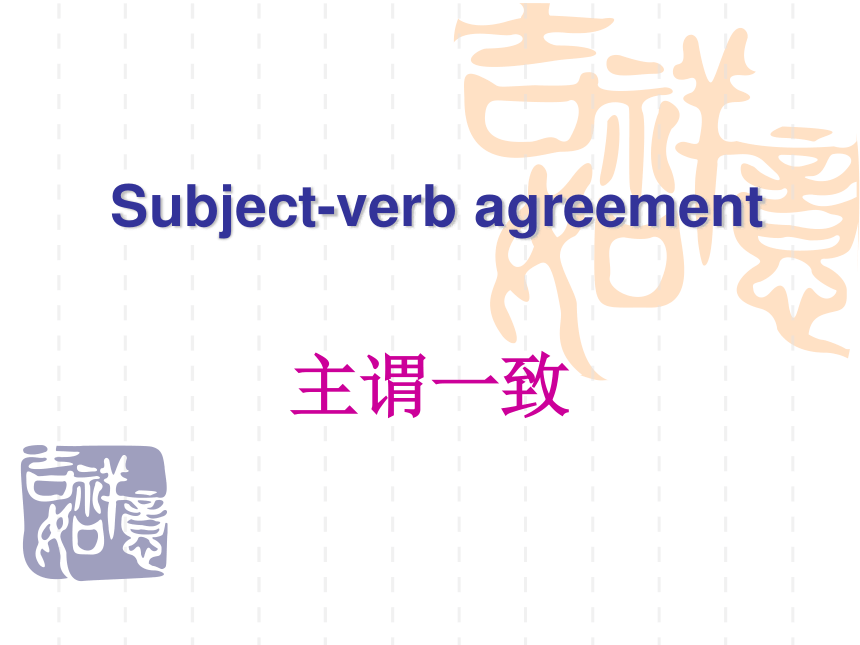 | |
| 格式 | zip | ||
| 文件大小 | 249.5KB | ||
| 资源类型 | 教案 | ||
| 版本资源 | 牛津译林版 | ||
| 科目 | 英语 | ||
| 更新时间 | 2017-10-01 21:01:28 | ||
图片预览


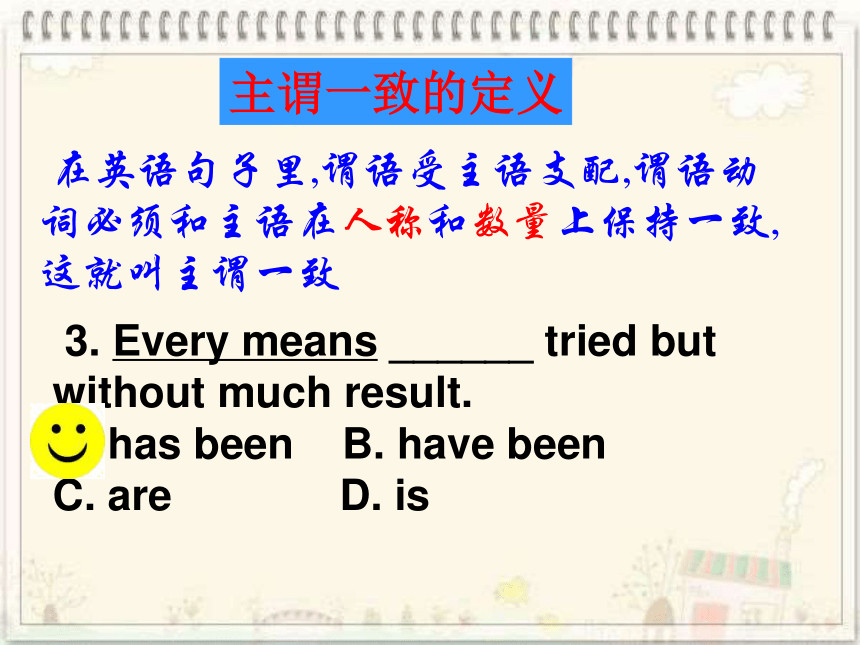
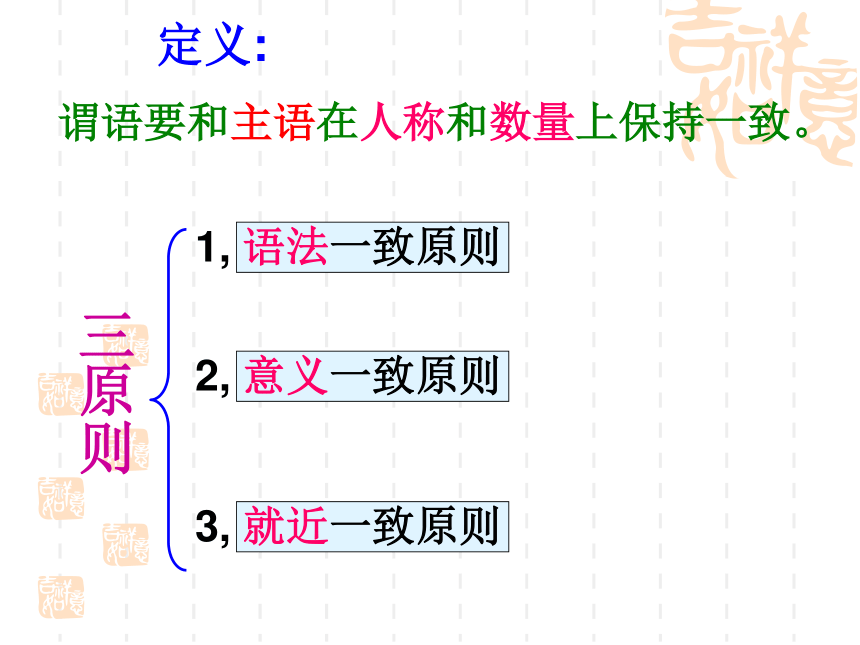

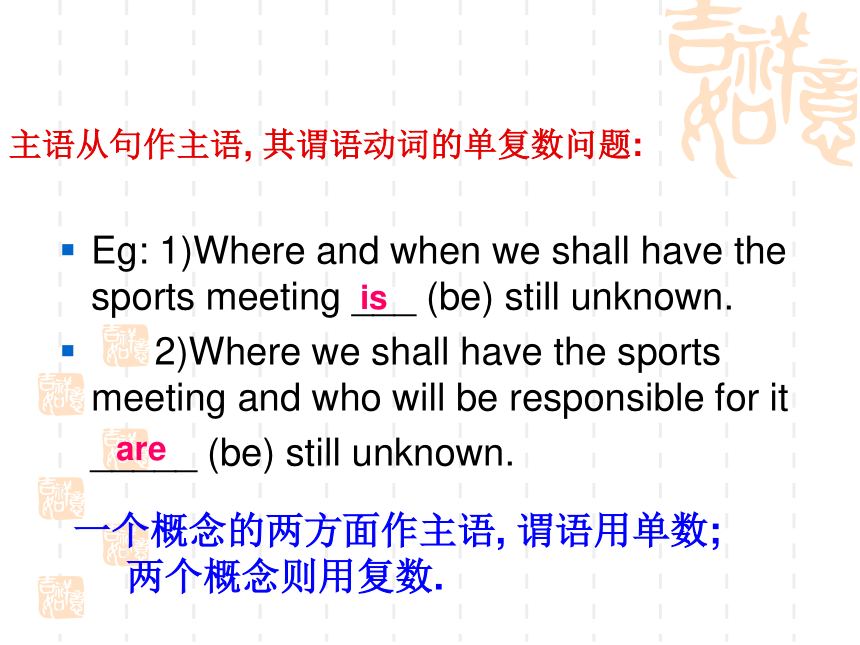
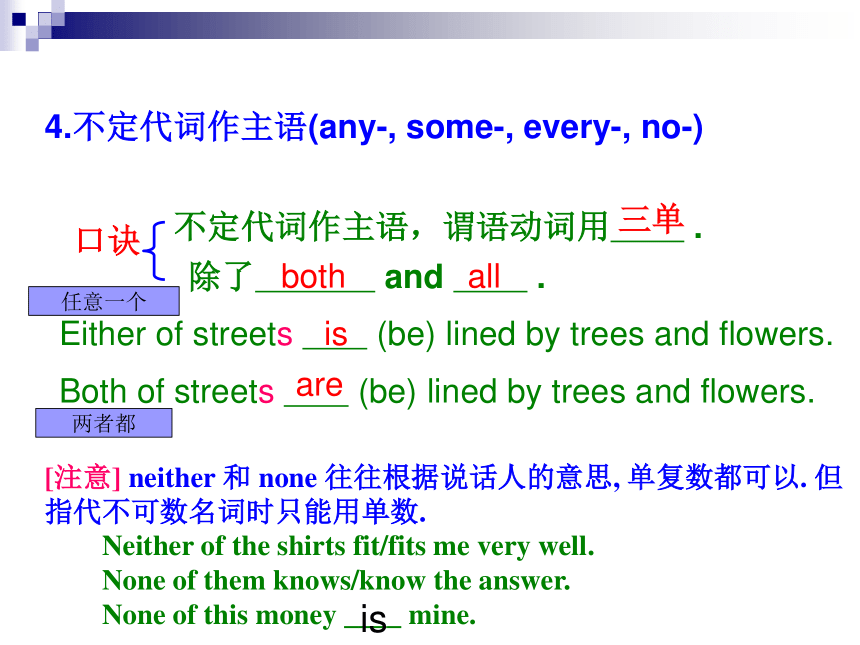
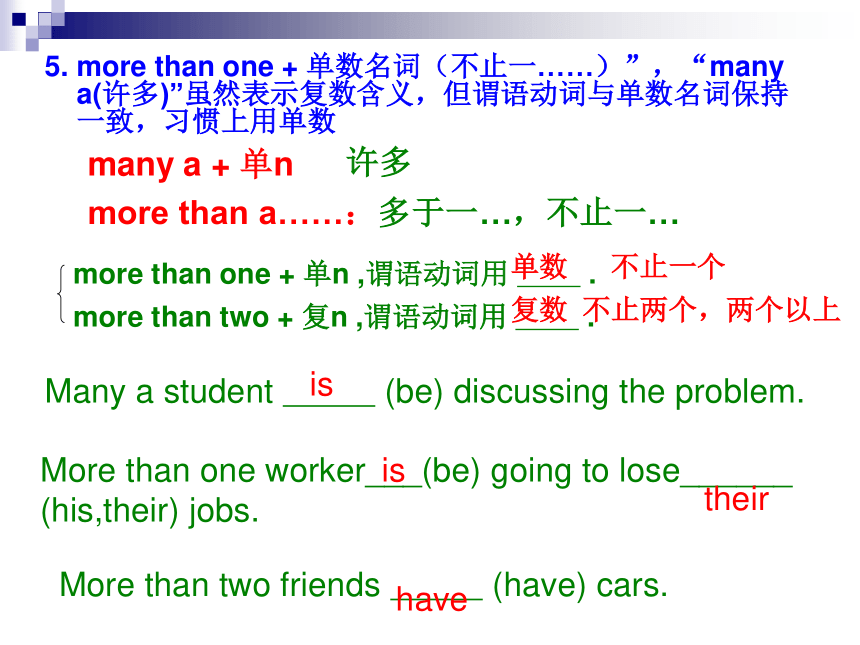
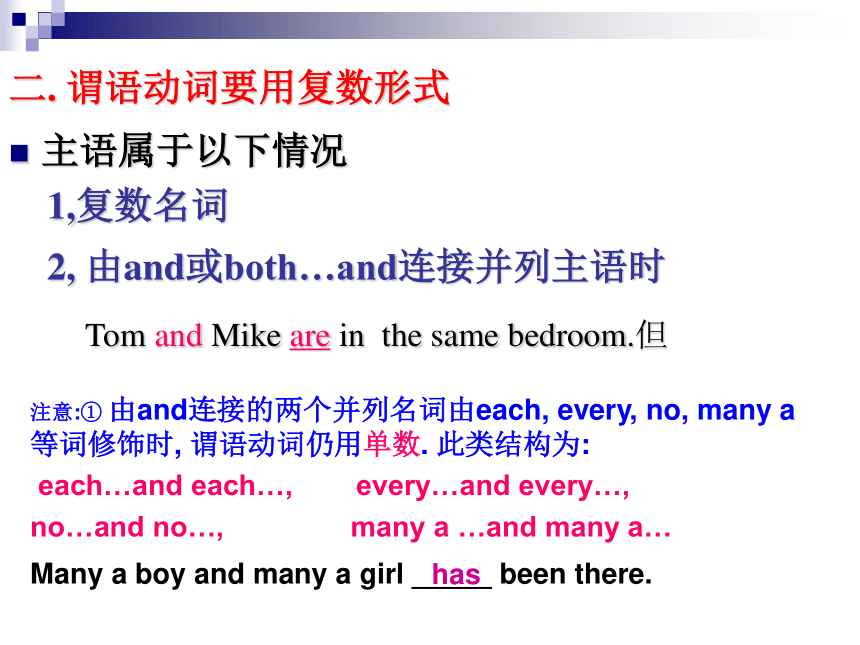
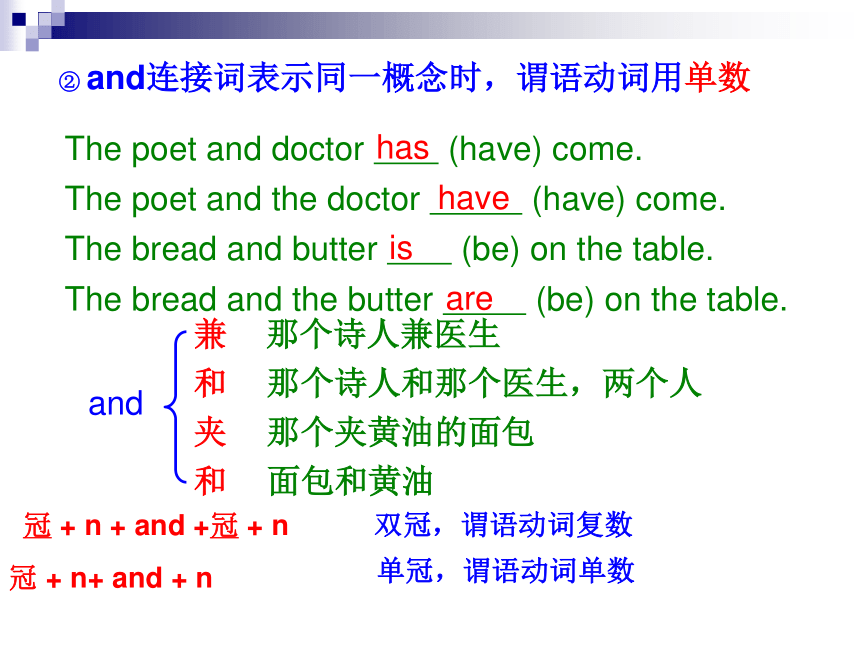
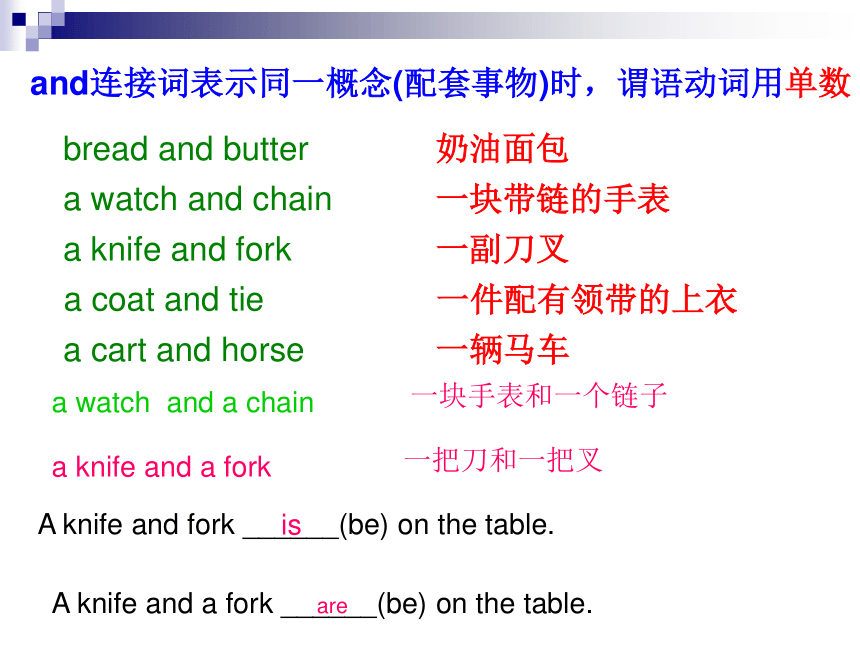
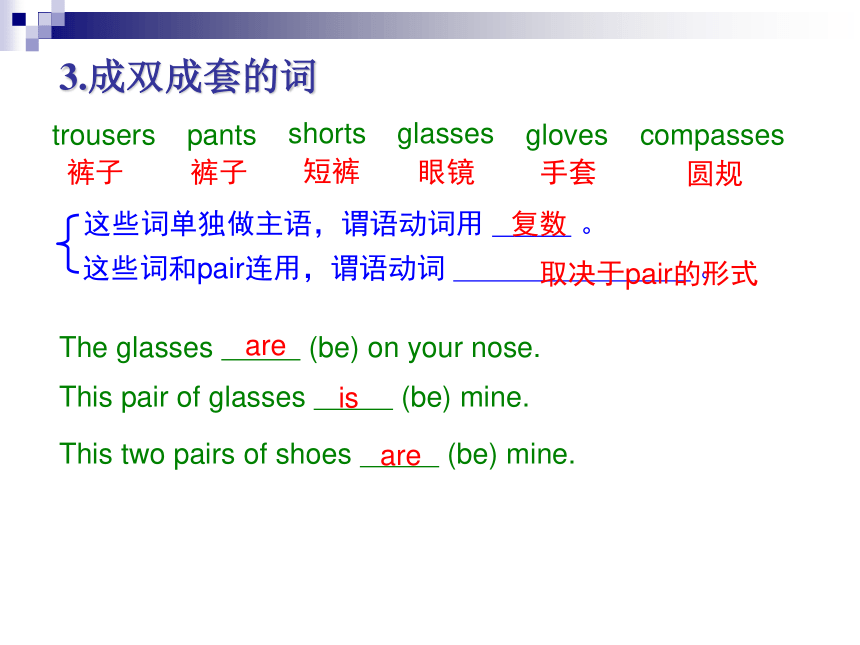
文档简介
课件42张PPT。Subject-verb agreement主谓一致Review(复习)Tom and Jack ___ to Hongkong next week.
A. is going B. are going C. go D.goes
2.There __ a pair of glasses on the desk, which is made in Taiwan.
A.being B.are C. is D.to be
在英语句子里,谓语受主语支配,谓语动词必须和主语在人称和数量上保持一致,这就叫主谓一致主谓一致的定义 3. Every means ______ tried but without much result.
A. has been B. have been
C. are D. is定义:谓语要和主语在人称和数量上保持一致。1, 语法一致原则2, 意义一致原则3, 就近一致原则三原则语法一致原则一. 谓语动词要用单数形式
主语是:
1.单数名词或不可数名词,谓语用单数
The food they served ______ (be) delicious.
2.动名词, 不定式或从句,谓语用单数
Skating in winter _______ (be) great fun.
To see _______(be) to believe.
That he is absent _______(worry) all his family.
Reading books and watching TV (be) my hobbies.
3. a large quantity(amount)of +不可数名词,谓语用单数
A large amount of water _____ what I need now.
isisisworriesis但是,多个动名词和不定式做主语,谓语动词用复数are主语从句作主语, 其谓语动词的单复数问题:Eg: 1)Where and when we shall have the sports meeting ___ (be) still unknown.
2)Where we shall have the sports meeting and who will be responsible for it
_____ (be) still unknown.isare一个概念的两方面作主语, 谓语用单数; 两个概念则用复数.4.不定代词作主语(any-, some-, every-, no-)口诀不定代词作主语,谓语动词用 .除了 and .bothall三单Either of streets (be) lined by trees and flowers.isBoth of streets (be) lined by trees and flowers.are任意一个两者都[注意] neither 和 none 往往根据说话人的意思, 单复数都可以. 但指代不可数名词时只能用单数. Neither of the shirts fit/fits me very well. None of them knows/know the answer. None of this money ____ mine.ismore than a……:多于一…,不止一…more than one + 单n ,谓语动词用 .单数复数More than two friends (have) cars.havemore than two + 复n ,谓语动词用 .不止一个不止两个,两个以上More than one worker___(be) going to lose______ (his,their) jobs. istheir5. more than one + 单数名词(不止一……)”,“many a(许多)”虽然表示复数含义,但谓语动词与单数名词保持一致,习惯上用单数
many a + 单n许多Many a student (be) discussing the problem.is二. 谓语动词要用复数形式主语属于以下情况
1,复数名词
2, 由and或both…and连接并列主语时
Tom and Mike are in the same bedroom.但注意:① 由and连接的两个并列名词由each, every, no, many a 等词修饰时, 谓语动词仍用单数. 此类结构为:
each…and each…, every…and every…,
no…and no…, many a …and many a…
Many a boy and many a girl _____ been there. has② and连接词表示同一概念时,谓语动词用单数The poet and doctor (have) come.hasThe poet and the doctor (have) come.haveThe bread and butter (be) on the table.isThe bread and the butter (be) on the table.areand兼和夹和那个诗人兼医生那个诗人和那个医生,两个人那个夹黄油的面包面包和黄油冠 + n + and +冠 + n冠 + n+ and + n双冠,谓语动词复数单冠,谓语动词单数and连接词表示同一概念(配套事物)时,谓语动词用单数bread and butter奶油面包a watch and chain一块带链的手表a knife and fork一副刀叉a coat and tie一件配有领带的上衣a cart and horse一辆马车a watch and a chain一块手表和一个链子a knife and a fork一把刀和一把叉A knife and fork ______(be) on the table.A knife and a fork ______(be) on the table.isare3.成双成套的词The glasses (be) on your nose. areThis pair of glasses (be) mine.istrouserspants裤子裤子shortsglasses短裤眼镜glovescompasses手套圆规这些词单独做主语,谓语动词用 。复数这些词和pair连用,谓语动词 。取决于pair的形式This two pairs of shoes (be) mine.are三. 谓语动词根据中心词确定单复数形式The teacher together with his students (be) reading
books now.isNobody but Tom and Mary (know) the secret.knows1.当主语后面接说明主语的修饰语, 如介词短语,谓语动词的单复数只看主语, 不受修饰成分的影响.主语 + with/together with(和…一起)as well as(和…一样)except/but(除了…,不再有)along with(和…一起)besides/in addition to(除了… 还有)谓语动词只看主语,
主语是复数就用复数,
主语是单数就用单数rather than (而不是…)1.French as well as English___(be) her favorite subject.
2.The girls along with him ___(be) my classmates.
3.Lily with her parents _____(go) to the park everyday.isaregoes2. 当pair of/ kind of/ type of/sort of等作主语时, 谓语动词与pair/kind/type/sort的单复数保持一致This kind of bananas _____(taste) delicious.
These pairs of trousers _____(fit) you.tastesfit注意: 主语为a large quantity(amount) of +名词,quantities (amounts) of+名词时,谓语动词根据主语中心词quantity或amount 的数决定。
Large quantities of water ____________ polluted.
are3.当分数、百分数,数量+of+名词作主语时,
谓语与该名词保持一致 the rest of剩下的,其余的most of大多数the majority/minority of…的大多数/少数plenty of大多数half of一半…分数百分数a part of一部分…all ofAll of us______ attended the lecture about Pompeii.
The rest of water _____(be) dirty.
Most of the lecture _____ about how the ancient city was discovered.havewasis注意: population, number 1, population 作主语时, 谓(单数)
分数/百分数等+population时, 谓(复数)
the population of that country __ very small.
seventy-five percent of the population of china ____ peasants.
2, a number of +名词复数(许多…), 谓(复数)
the number of +名词复数(…的数量),谓(单数)
A number of students ___ (go) to the library.
The number of students ____(be) 40.is aregois总结:
一,谓语用单数,当主语是:
1,单数名语,不可数名词
2,不定式,动名词, 从句
3,不定代词(除both, all),( none, neither可单可复,后跟不可数
名词,则只能用单数)
4, a large quantity(amount) of +名词
5, many a /more than one + 名词
二, 谓语用复数, 当主语是:
1,复数名词
2, 由and或both…and连接并列主语时(and连接词表示同一
概念时; 由and连接的两个并列名词由each, every, no,
many a 等词修饰时)
3.成双成套的词(如trousers, pants单独做主语时,谓用单数,
和pair连用时,谓取决于pair的形式)
二,谓语动词根据中心词确定单复数形式,当主语是:
1.当主语后面接说明主语的修饰语, 如介词短语,谓语动词的单复数只看主语(如with/together with)
2. 当pair of/ kind of/ type of/sort of等作主语时, 谓语动词与pair/kind/type/sort保持一致
3.当分数、百分数,数量+of+名词作主语时,谓语与该名词保持一致. (如the rest of, a part of)
4. 两个特殊的词: population, number
1) population 作主语时, 谓(单数)
分数等+population时, 谓(复数)
2) a number of +名词复数, 谓(复数)
the number of +名词复数,谓(单数)
Fill in the blanks with the right form of the give verbs.
______ (have) your classmates finished their homework?
(2) My friend and I _____ (want) to play outside after watching TV.
(3) Most of the students _____ (prefer) English to Mathematics.
(4) Collecting stamps _____ (be) one of his favorite pastimes.Have wantpreferis Exercise1. All the professional personnel _____ invited to attend the meeting. A. have? ?B. were?? C. has? ?D. was 2. Every doctor and every nurse ______ a new hospital for SARS patients. A. has founded? B. have found ? C. expects to found? D. has to be found 3. The number of students in this school ______. A. is increasing? B. are increasing? C. is increased? D. are increased BCA6) 不定代词each, every, no所修饰的名词 及each…and each…, every…and every…,no…and no…, many a …and many a…结构作主语时,谓语动词仍用单数形式。如: _________________________________________5. You, who______ his good friend, should help him get out of trouble. A. am?? B. is? ?C. are?? D. was 6. A pair of shoes ______ under the bed. A. was ??B. were??C. has been? D. have been 7. Many a student ______ the film now. A. has seen?B. had seen?C. have seen?D. saw 4. The questions which ______ to yours are not easy to answer. A. is the same? B. are different? C. is like?? D. are similar DCAA_______________________如果主语有more than one… 或many a… 构成,尽管从意义上看是复数内容,但它的谓语动词仍然用单数形式。如:
22. Each soldier and each sailor ______ a thick coat. A. are given ?B. was given? C. being given? D. were given 23. Where ______ dirt, there are flies. A. there has?B. is??C. there is??D. there are 24. A fork and knife ______ on the table. A. is??B. are??C. has been?D. have been 25. When and where to build the factory ______ yet. A. is not decided? B. are not decided? C. has not decided? D. have not decided CAAB_____________________a watch and chain 一块带链的表? a needle and thread /a coat and tie 配有领带的上衣 A knife and fork is needed for a western meal. 吃西餐时要用刀和叉。 The cart and horse is coming. 马车来了。 (配套事物)一.时间金钱问题 基数词+表时间/距离/价值或其他度量单位的名词时,谓语动词通常用单数形式,这是由于作主语的名词在概念上是一个整体.Ten dollars is a price for that hat.Thirty miles is not a long distance.如果把这些数量概念看作组成数量的个体时,谓语动词用复数Ten years have passed since he came to this city.意义一致原则二. 书名,报刊名,戏剧句, 国家名当此类名词或词组作主语时,常看作一个整体, 谓语动词用单数形式.
New York Times is a very good newspaper.
The United States was founded in 1776.三.冠词The + 姓氏 + s :表示一家人,谓语动词用 。复数The + adj :表示一类人,谓语动词用 。复数The Blacks (be) watching TV now.areThe good (be) happy.arethe dead死人the living活人the rich富人the poor穷人the sick病人the young年轻人the old老人the disabled残疾人the blind盲人“the +adj.”指个人或抽象概念时, 谓语用______ 形式.单数The old is yours,not mine. 当主语是army, audience, class, crowd, band, crowd, class, dozen, family, public 和team 等集合名词时,如果表达整体概念,谓语动词用单数,如果强调集合里的个体,谓语动词用复数。
Our team ____ very important to me.
Our team ______ now making their way to Xinjiang.
The cattle_______ eating grass near the river.
特殊4: 集合名词 people, police, cattle 作主语时,谓语动词无论什么时候都应当使用复数形式。isareare四. 集体名词团队的词确定单复数family单数classteamclubgroup家人同学队员成员组员家庭班级队俱乐部组复数指团队中的成员,就用复数。指整个团队,就用单数。团队的词确定单复数My family (be) very small.isMy family (be) having lunch now.areThe police _________ searching the lost boy.are五. 单复数形式相同的名词
sheep deer means aircraft Chinese German Japanese series Swiss等
根据具体意义决定
Every means _____ been tried.=
All means ______ been tried.
hashave意义一致原则要点总结一.时间,距离,金钱,度量衡
二. 书名,报刊名,戏剧句, 国家名
三. The + 姓氏 + s(一家人) The + adj(一类人)
四. 集体名词
五.单复数形式相同的名词(如sheep deer)
either A or Bneither A nor B就近一致原则not only A but also Bthere be A and B或者 A 或者 B既不 A 也不 B不但 A 而且 B有 A 和 B谓语与最靠近的名词(代词)保持一致。Either you or he (be) right.isEither he or you (be) right.areBoth you and he (be) right.Both he and you (be) right.areareboth A and B:两者都……,不适用就近原则。就近原则Not only the childen but also their father (like)
playing computer games.likesNot only their father but also the childen (like)
playing computer games.like 就近一致原则总结
当用either … or、neither … nor、not only … but also… 、whether…or和not …but…连接句子主语时,采取 “就近原则”。(there be 句型也是就近原则)
Either the team leader or the guides _____looking after the students.
Not only the guides but also the team leader ____ looking after the students.
There ______ two pencils and a knife in my pencil box.areisare(1) _____ (be) your family a big one?
(2) All my family _____ (get) up early in the morning.
(3) Neither his father nor his mother ______ (play) the piano.
(4) The remains of the old castle _____ (be) destroyed in World War Two.
(5) Not only Jim but also his Parents _____ (be) going to see you next Sunday.arewereplaysgetIs Exercise8. The police ______ the lost boy all day. A. is searching for? B. are searching for? C. searches for? D. search 9. Not only I but also she ______ this. A. know?? B. knows ? ?C. am known? D. known 10.The news that she is coming to visit us ______ exciting. A. is? ?B. was?? C. were ?? D. are DBA主语形式虽为单数,但意义为复数, 谓语动词用复数。如:
The crowd were surrounding the government official.???people, police, cattle______________并列主语用连词or, either…or, neither…nor, not only…but also等连接,谓语应同相邻的主语保持人称和数的一致。 13. Five minus three ______ two. A. is?? B. are?? C. was?? D. were 14. Twenty dollars ______ enough for the coat. A. is? ?B. are?? C. was?? D. were 11. The crowd ______ for their lives A. were run? B. were running? C. was run?? D. was running BAA当名词词组中心词为表示度量、距离、金额、时间等复数名词时,往往可以根据意义一致的原则,把这些复数名词看作一个整体,谓语动词用单数形式。如: ____________________________________________15.The first two questions were easy, but the rest of them ______ not. A. was??B. were??C. being??D. to be 16.Either Tom or I ______ to blame. A. to be??B. am??C. are??D. is 17.______ good exercise. A. Climbing hills is?? B. Climbing the hill is C. The climbing hills are?? D. The climbing of hills are BBA 如果名词词组的中心词是all, most, rest, some, neither, none, no等词,所指是复数意义,谓语动词用复数形式;反之用单 数。如: 18. Something ______ gone wrong with my TV set. A. has??B. have??C. is??D. are 19. This is one of the best films that ______ this year. A. is appearing?? B. appear C. has appeared? D. have appeared 20. Half of the students ______ made the same mistake. A. has??B. have??C. is??D. are 21. The old ______ taken good care of in our country. A. is??B. has??C. are??D. have ADBC______________________ 关系代词which, who, that在定语从句中作主语时,其谓语动词的数应与其前的先行词 的数保持一致。 half of, (a) part of修饰可数名词单数及不可数名词作主语时,谓语动词用单数,修饰可数名词复数作主语时,谓语动词用复数。 ____________________________________“the+形容词(或过去分词或现在分词)”如:the brave, the poor, the rich, the blind, the young, the old, the sick, the wounded, the injured, the unemployed, the dying, the living 等结构担任主语表示一类人时,谓语动词常用复数形式;但也有少数的形容词或过去分词与定冠词连用指个别或表示抽象的概念时,谓语动词用单数。 26. Snow White and the Seven Dwarfs ______ popular with people of all ages since it was made into the first full-length cartoon. A. were??B. was??C. has been?D. is 27.All but one ______ here just now. A. is?? B. was??C. has been?D. were 28. Three-fourths of the surface of the earth ______ sea. A. is?? B. are?? C. were? D. has been 29. Nobody but Jane ______ the secret. A. knows?? B. know?? C. have known ? D. is known CDAA形复意单的单词有:news,works 和一些以s结尾的书名、组织机构的名称(如: “The Selected Poems of Li Bai”, the United States, the United Nations) 以及以ics结尾的学科名称(如:physics,politics,maths,economics等)。 当主语后面跟有as well as, as much as, no less than, along with, with, like, rather than, together with, but, except, besides, including, in addition to等引导的词组时,其谓语动词的单、复数按主语的单、复数而定。 _________________________________________________
A. is going B. are going C. go D.goes
2.There __ a pair of glasses on the desk, which is made in Taiwan.
A.being B.are C. is D.to be
在英语句子里,谓语受主语支配,谓语动词必须和主语在人称和数量上保持一致,这就叫主谓一致主谓一致的定义 3. Every means ______ tried but without much result.
A. has been B. have been
C. are D. is定义:谓语要和主语在人称和数量上保持一致。1, 语法一致原则2, 意义一致原则3, 就近一致原则三原则语法一致原则一. 谓语动词要用单数形式
主语是:
1.单数名词或不可数名词,谓语用单数
The food they served ______ (be) delicious.
2.动名词, 不定式或从句,谓语用单数
Skating in winter _______ (be) great fun.
To see _______(be) to believe.
That he is absent _______(worry) all his family.
Reading books and watching TV (be) my hobbies.
3. a large quantity(amount)of +不可数名词,谓语用单数
A large amount of water _____ what I need now.
isisisworriesis但是,多个动名词和不定式做主语,谓语动词用复数are主语从句作主语, 其谓语动词的单复数问题:Eg: 1)Where and when we shall have the sports meeting ___ (be) still unknown.
2)Where we shall have the sports meeting and who will be responsible for it
_____ (be) still unknown.isare一个概念的两方面作主语, 谓语用单数; 两个概念则用复数.4.不定代词作主语(any-, some-, every-, no-)口诀不定代词作主语,谓语动词用 .除了 and .bothall三单Either of streets (be) lined by trees and flowers.isBoth of streets (be) lined by trees and flowers.are任意一个两者都[注意] neither 和 none 往往根据说话人的意思, 单复数都可以. 但指代不可数名词时只能用单数. Neither of the shirts fit/fits me very well. None of them knows/know the answer. None of this money ____ mine.ismore than a……:多于一…,不止一…more than one + 单n ,谓语动词用 .单数复数More than two friends (have) cars.havemore than two + 复n ,谓语动词用 .不止一个不止两个,两个以上More than one worker___(be) going to lose______ (his,their) jobs. istheir5. more than one + 单数名词(不止一……)”,“many a(许多)”虽然表示复数含义,但谓语动词与单数名词保持一致,习惯上用单数
many a + 单n许多Many a student (be) discussing the problem.is二. 谓语动词要用复数形式主语属于以下情况
1,复数名词
2, 由and或both…and连接并列主语时
Tom and Mike are in the same bedroom.但注意:① 由and连接的两个并列名词由each, every, no, many a 等词修饰时, 谓语动词仍用单数. 此类结构为:
each…and each…, every…and every…,
no…and no…, many a …and many a…
Many a boy and many a girl _____ been there. has② and连接词表示同一概念时,谓语动词用单数The poet and doctor (have) come.hasThe poet and the doctor (have) come.haveThe bread and butter (be) on the table.isThe bread and the butter (be) on the table.areand兼和夹和那个诗人兼医生那个诗人和那个医生,两个人那个夹黄油的面包面包和黄油冠 + n + and +冠 + n冠 + n+ and + n双冠,谓语动词复数单冠,谓语动词单数and连接词表示同一概念(配套事物)时,谓语动词用单数bread and butter奶油面包a watch and chain一块带链的手表a knife and fork一副刀叉a coat and tie一件配有领带的上衣a cart and horse一辆马车a watch and a chain一块手表和一个链子a knife and a fork一把刀和一把叉A knife and fork ______(be) on the table.A knife and a fork ______(be) on the table.isare3.成双成套的词The glasses (be) on your nose. areThis pair of glasses (be) mine.istrouserspants裤子裤子shortsglasses短裤眼镜glovescompasses手套圆规这些词单独做主语,谓语动词用 。复数这些词和pair连用,谓语动词 。取决于pair的形式This two pairs of shoes (be) mine.are三. 谓语动词根据中心词确定单复数形式The teacher together with his students (be) reading
books now.isNobody but Tom and Mary (know) the secret.knows1.当主语后面接说明主语的修饰语, 如介词短语,谓语动词的单复数只看主语, 不受修饰成分的影响.主语 + with/together with(和…一起)as well as(和…一样)except/but(除了…,不再有)along with(和…一起)besides/in addition to(除了… 还有)谓语动词只看主语,
主语是复数就用复数,
主语是单数就用单数rather than (而不是…)1.French as well as English___(be) her favorite subject.
2.The girls along with him ___(be) my classmates.
3.Lily with her parents _____(go) to the park everyday.isaregoes2. 当pair of/ kind of/ type of/sort of等作主语时, 谓语动词与pair/kind/type/sort的单复数保持一致This kind of bananas _____(taste) delicious.
These pairs of trousers _____(fit) you.tastesfit注意: 主语为a large quantity(amount) of +名词,quantities (amounts) of+名词时,谓语动词根据主语中心词quantity或amount 的数决定。
Large quantities of water ____________ polluted.
are3.当分数、百分数,数量+of+名词作主语时,
谓语与该名词保持一致 the rest of剩下的,其余的most of大多数the majority/minority of…的大多数/少数plenty of大多数half of一半…分数百分数a part of一部分…all ofAll of us______ attended the lecture about Pompeii.
The rest of water _____(be) dirty.
Most of the lecture _____ about how the ancient city was discovered.havewasis注意: population, number 1, population 作主语时, 谓(单数)
分数/百分数等+population时, 谓(复数)
the population of that country __ very small.
seventy-five percent of the population of china ____ peasants.
2, a number of +名词复数(许多…), 谓(复数)
the number of +名词复数(…的数量),谓(单数)
A number of students ___ (go) to the library.
The number of students ____(be) 40.is aregois总结:
一,谓语用单数,当主语是:
1,单数名语,不可数名词
2,不定式,动名词, 从句
3,不定代词(除both, all),( none, neither可单可复,后跟不可数
名词,则只能用单数)
4, a large quantity(amount) of +名词
5, many a /more than one + 名词
二, 谓语用复数, 当主语是:
1,复数名词
2, 由and或both…and连接并列主语时(and连接词表示同一
概念时; 由and连接的两个并列名词由each, every, no,
many a 等词修饰时)
3.成双成套的词(如trousers, pants单独做主语时,谓用单数,
和pair连用时,谓取决于pair的形式)
二,谓语动词根据中心词确定单复数形式,当主语是:
1.当主语后面接说明主语的修饰语, 如介词短语,谓语动词的单复数只看主语(如with/together with)
2. 当pair of/ kind of/ type of/sort of等作主语时, 谓语动词与pair/kind/type/sort保持一致
3.当分数、百分数,数量+of+名词作主语时,谓语与该名词保持一致. (如the rest of, a part of)
4. 两个特殊的词: population, number
1) population 作主语时, 谓(单数)
分数等+population时, 谓(复数)
2) a number of +名词复数, 谓(复数)
the number of +名词复数,谓(单数)
Fill in the blanks with the right form of the give verbs.
______ (have) your classmates finished their homework?
(2) My friend and I _____ (want) to play outside after watching TV.
(3) Most of the students _____ (prefer) English to Mathematics.
(4) Collecting stamps _____ (be) one of his favorite pastimes.Have wantpreferis Exercise1. All the professional personnel _____ invited to attend the meeting. A. have? ?B. were?? C. has? ?D. was 2. Every doctor and every nurse ______ a new hospital for SARS patients. A. has founded? B. have found ? C. expects to found? D. has to be found 3. The number of students in this school ______. A. is increasing? B. are increasing? C. is increased? D. are increased BCA6) 不定代词each, every, no所修饰的名词 及each…and each…, every…and every…,no…and no…, many a …and many a…结构作主语时,谓语动词仍用单数形式。如: _________________________________________5. You, who______ his good friend, should help him get out of trouble. A. am?? B. is? ?C. are?? D. was 6. A pair of shoes ______ under the bed. A. was ??B. were??C. has been? D. have been 7. Many a student ______ the film now. A. has seen?B. had seen?C. have seen?D. saw 4. The questions which ______ to yours are not easy to answer. A. is the same? B. are different? C. is like?? D. are similar DCAA_______________________如果主语有more than one… 或many a… 构成,尽管从意义上看是复数内容,但它的谓语动词仍然用单数形式。如:
22. Each soldier and each sailor ______ a thick coat. A. are given ?B. was given? C. being given? D. were given 23. Where ______ dirt, there are flies. A. there has?B. is??C. there is??D. there are 24. A fork and knife ______ on the table. A. is??B. are??C. has been?D. have been 25. When and where to build the factory ______ yet. A. is not decided? B. are not decided? C. has not decided? D. have not decided CAAB_____________________a watch and chain 一块带链的表? a needle and thread /a coat and tie 配有领带的上衣 A knife and fork is needed for a western meal. 吃西餐时要用刀和叉。 The cart and horse is coming. 马车来了。 (配套事物)一.时间金钱问题 基数词+表时间/距离/价值或其他度量单位的名词时,谓语动词通常用单数形式,这是由于作主语的名词在概念上是一个整体.Ten dollars is a price for that hat.Thirty miles is not a long distance.如果把这些数量概念看作组成数量的个体时,谓语动词用复数Ten years have passed since he came to this city.意义一致原则二. 书名,报刊名,戏剧句, 国家名当此类名词或词组作主语时,常看作一个整体, 谓语动词用单数形式.
New York Times is a very good newspaper.
The United States was founded in 1776.三.冠词The + 姓氏 + s :表示一家人,谓语动词用 。复数The + adj :表示一类人,谓语动词用 。复数The Blacks (be) watching TV now.areThe good (be) happy.arethe dead死人the living活人the rich富人the poor穷人the sick病人the young年轻人the old老人the disabled残疾人the blind盲人“the +adj.”指个人或抽象概念时, 谓语用______ 形式.单数The old is yours,not mine. 当主语是army, audience, class, crowd, band, crowd, class, dozen, family, public 和team 等集合名词时,如果表达整体概念,谓语动词用单数,如果强调集合里的个体,谓语动词用复数。
Our team ____ very important to me.
Our team ______ now making their way to Xinjiang.
The cattle_______ eating grass near the river.
特殊4: 集合名词 people, police, cattle 作主语时,谓语动词无论什么时候都应当使用复数形式。isareare四. 集体名词团队的词确定单复数family单数classteamclubgroup家人同学队员成员组员家庭班级队俱乐部组复数指团队中的成员,就用复数。指整个团队,就用单数。团队的词确定单复数My family (be) very small.isMy family (be) having lunch now.areThe police _________ searching the lost boy.are五. 单复数形式相同的名词
sheep deer means aircraft Chinese German Japanese series Swiss等
根据具体意义决定
Every means _____ been tried.=
All means ______ been tried.
hashave意义一致原则要点总结一.时间,距离,金钱,度量衡
二. 书名,报刊名,戏剧句, 国家名
三. The + 姓氏 + s(一家人) The + adj(一类人)
四. 集体名词
五.单复数形式相同的名词(如sheep deer)
either A or Bneither A nor B就近一致原则not only A but also Bthere be A and B或者 A 或者 B既不 A 也不 B不但 A 而且 B有 A 和 B谓语与最靠近的名词(代词)保持一致。Either you or he (be) right.isEither he or you (be) right.areBoth you and he (be) right.Both he and you (be) right.areareboth A and B:两者都……,不适用就近原则。就近原则Not only the childen but also their father (like)
playing computer games.likesNot only their father but also the childen (like)
playing computer games.like 就近一致原则总结
当用either … or、neither … nor、not only … but also… 、whether…or和not …but…连接句子主语时,采取 “就近原则”。(there be 句型也是就近原则)
Either the team leader or the guides _____looking after the students.
Not only the guides but also the team leader ____ looking after the students.
There ______ two pencils and a knife in my pencil box.areisare(1) _____ (be) your family a big one?
(2) All my family _____ (get) up early in the morning.
(3) Neither his father nor his mother ______ (play) the piano.
(4) The remains of the old castle _____ (be) destroyed in World War Two.
(5) Not only Jim but also his Parents _____ (be) going to see you next Sunday.arewereplaysgetIs Exercise8. The police ______ the lost boy all day. A. is searching for? B. are searching for? C. searches for? D. search 9. Not only I but also she ______ this. A. know?? B. knows ? ?C. am known? D. known 10.The news that she is coming to visit us ______ exciting. A. is? ?B. was?? C. were ?? D. are DBA主语形式虽为单数,但意义为复数, 谓语动词用复数。如:
The crowd were surrounding the government official.???people, police, cattle______________并列主语用连词or, either…or, neither…nor, not only…but also等连接,谓语应同相邻的主语保持人称和数的一致。 13. Five minus three ______ two. A. is?? B. are?? C. was?? D. were 14. Twenty dollars ______ enough for the coat. A. is? ?B. are?? C. was?? D. were 11. The crowd ______ for their lives A. were run? B. were running? C. was run?? D. was running BAA当名词词组中心词为表示度量、距离、金额、时间等复数名词时,往往可以根据意义一致的原则,把这些复数名词看作一个整体,谓语动词用单数形式。如: ____________________________________________15.The first two questions were easy, but the rest of them ______ not. A. was??B. were??C. being??D. to be 16.Either Tom or I ______ to blame. A. to be??B. am??C. are??D. is 17.______ good exercise. A. Climbing hills is?? B. Climbing the hill is C. The climbing hills are?? D. The climbing of hills are BBA 如果名词词组的中心词是all, most, rest, some, neither, none, no等词,所指是复数意义,谓语动词用复数形式;反之用单 数。如: 18. Something ______ gone wrong with my TV set. A. has??B. have??C. is??D. are 19. This is one of the best films that ______ this year. A. is appearing?? B. appear C. has appeared? D. have appeared 20. Half of the students ______ made the same mistake. A. has??B. have??C. is??D. are 21. The old ______ taken good care of in our country. A. is??B. has??C. are??D. have ADBC______________________ 关系代词which, who, that在定语从句中作主语时,其谓语动词的数应与其前的先行词 的数保持一致。 half of, (a) part of修饰可数名词单数及不可数名词作主语时,谓语动词用单数,修饰可数名词复数作主语时,谓语动词用复数。 ____________________________________“the+形容词(或过去分词或现在分词)”如:the brave, the poor, the rich, the blind, the young, the old, the sick, the wounded, the injured, the unemployed, the dying, the living 等结构担任主语表示一类人时,谓语动词常用复数形式;但也有少数的形容词或过去分词与定冠词连用指个别或表示抽象的概念时,谓语动词用单数。 26. Snow White and the Seven Dwarfs ______ popular with people of all ages since it was made into the first full-length cartoon. A. were??B. was??C. has been?D. is 27.All but one ______ here just now. A. is?? B. was??C. has been?D. were 28. Three-fourths of the surface of the earth ______ sea. A. is?? B. are?? C. were? D. has been 29. Nobody but Jane ______ the secret. A. knows?? B. know?? C. have known ? D. is known CDAA形复意单的单词有:news,works 和一些以s结尾的书名、组织机构的名称(如: “The Selected Poems of Li Bai”, the United States, the United Nations) 以及以ics结尾的学科名称(如:physics,politics,maths,economics等)。 当主语后面跟有as well as, as much as, no less than, along with, with, like, rather than, together with, but, except, besides, including, in addition to等引导的词组时,其谓语动词的单、复数按主语的单、复数而定。 _________________________________________________
